The movement of energy depends on the efficiency of energy flow
As we have discussed, the organisms in each trophic level must obtain energy, assimilate some fraction of the energy they obtain, and then use some of the assimilated energy for respiration. Whatever remains goes to growth and reproduction. At each step, different organisms vary in the efficiency with which they obtain and retain energy. These efficiencies, combined with trophic interactions that affect the abundance of other trophic levels, affect the amount of energy and biomass that can be supported in a given trophic level. These factors also affect how many trophic levels can exist in an ecosystem. In this section, we will explore patterns in the amounts of energy and biomass that exist in different trophic levels. We will then examine the various efficiencies of energy transfer in trophic groups and how these differences affect the number of trophic levels found in an ecosystem.
Trophic Pyramids
A useful way to think about the distribution of energy or biomass among the trophic groups in an ecosystem is by drawing a trophic pyramid, which is a chart composed of stacked rectangles representing the relative amount of energy or biomass in each trophic group. The first person to consider the flow of energy between trophic levels was Raymond Lindeman, an ecologist who conducted his doctoral dissertation on Cedar Bog Lake in Minnesota during the 1930s. As Lindeman collected data on the energy and biomass produced by different trophic levels in the lake, he concluded that energy must be lost as it moves from one trophic level to the next. He demonstrated that this was the case when he created a trophic pyramid that displayed the percentage of the total energy existing at each trophic level, known as a pyramid of energy. As you can see from his data in Figure 20.13, each trophic level in the lake contained less energy than the trophic level below it.
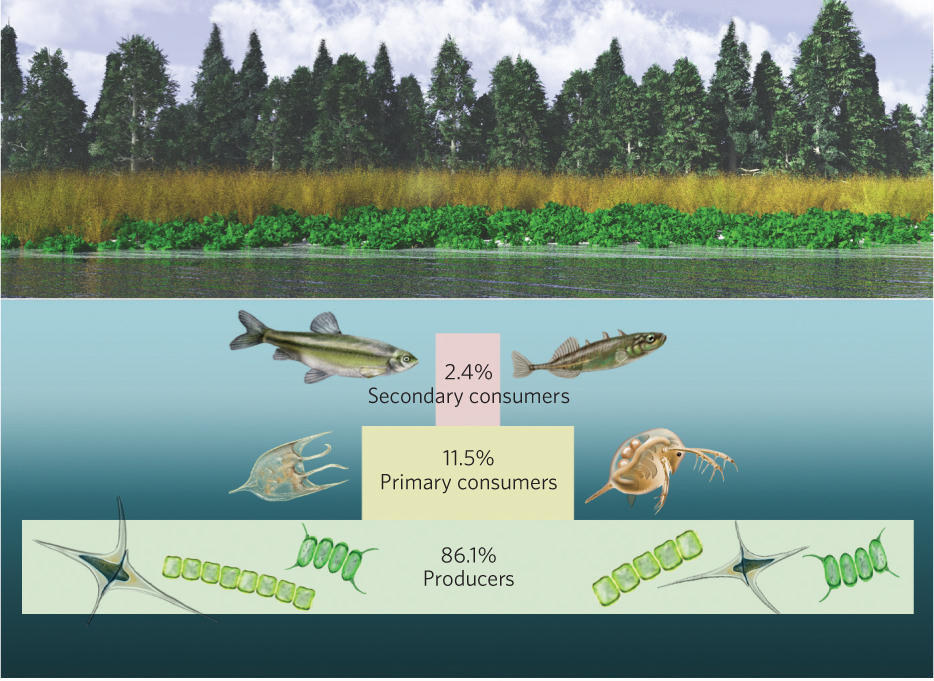
Trophic pyramid A chart composed of stacked rectangles representing the amount of energy or biomass in each trophic group.
Pyramid of energy A trophic pyramid that displays the total energy existing at each trophic level.
480
Pyramids of energy are just one way of representing the distribution of organisms in an ecosystem. We can also create a trophic pyramid that represents the standing crop of organisms present in different trophic groups, which is known as a pyramid of biomass. In terrestrial ecosystems, the distribution of biomass among trophic levels looks quite similar to the pyramid of energy. As Figure 20.14a shows, the greatest amount of biomass occurs in producers, with less biomass in primary and secondary consumers. For example, consider the biomass in a forest ecosystem. The greatest portion of the biomass occurs in producers, which include trees, shrubs, and wildflowers. There is considerably less biomass in primary consumers, which include herbivorous birds, mammals, and insects. There is even less biomass in secondary consumers, which include hawks, owls, and carnivorous mammals. A similar scenario exists in the grassland ecosystem of Africa. All the grass in Africa piled together would dwarf a mound of all the grasshoppers, gazelles, zebras, wildebeests, and other animals that eat grass. That mound of herbivores, in turn, would dwarf the relatively tiny mound of all the lions, hyenas, and other carnivores that feed on them.
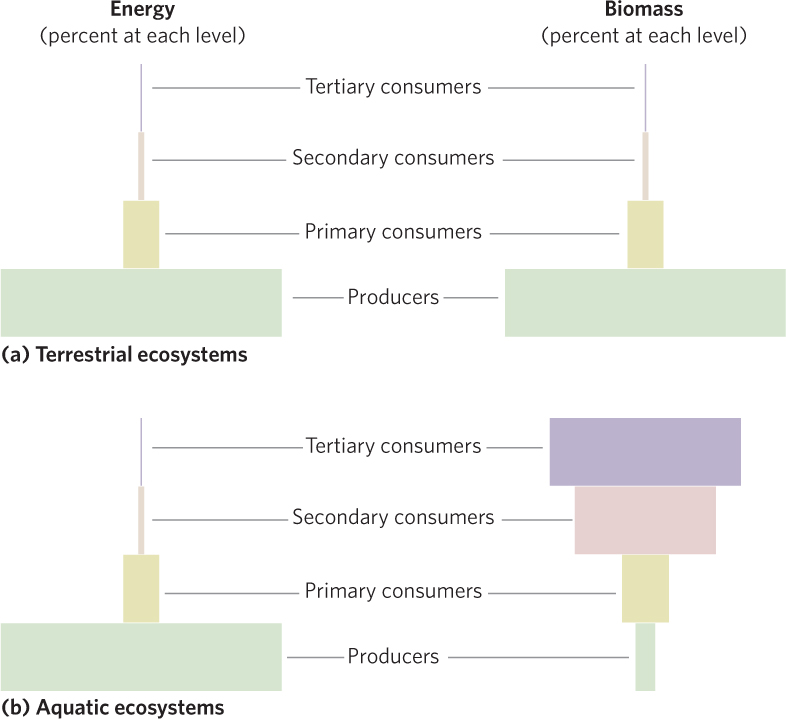
Pyramid of biomass A trophic pyramid that represents the standing crop of organisms present in different trophic groups.
In aquatic ecosystems, the pyramid of biomass has a very different shape. In these ecosystems, the major producers are the phytoplankton, the tiny algae that float or swim through the water. Unlike trees and shrubs, algae have short lives with rapid reproduction, and they are consumed in large numbers. As a result, although the productivity of algae is much higher than the consumers of algae, the standing biomass of algae is often much lower than the standing biomass of the consumers of algae. This creates an inverted pyramid, as illustrated in Figure 20.14b.
481
The Efficiencies of Energy Transfers
As we discussed, the amount of energy that moves from one trophic level to another determines how much energy or biomass can exist at each trophic level. The amount of energy that is transferred between adjacent trophic levels depends on several steps that occur within each trophic level and include consumption, assimilation, and production. To determine the amount of energy transfer, we need a way to quantify the movement of energy in each of these steps. When we consider the transfer of energy from one trophic level to another, we can examine either the absolute amount of energy that is transferred or the percentage of available energy that is transferred, which is a measure of efficiency.
Consumption Efficiency
Consumption efficiency The percentage of energy or biomass in a trophic level that is consumed by the next higher trophic level.
Turning back to Figure 20.4, we see that the first step in the transfer of energy from one trophic level to another is the consumption of energy at the lower trophic level. Some of the total amount of energy available in the lower trophic level is consumed and the rest is left to become dead organic matter. The percentage of energy or biomass in a trophic level that is consumed by the next higher trophic level is known as the consumption efficiency.
Consumption efficiency is calculated using the following equation:

For example, herbivores might only consume 1 J of energy for every 10 J of energy available in a field of wildflowers because many of the plant species possess defenses against herbivores. In this case, the consumption efficiency of the herbivores would be 10 percent. In ecosystems containing producers with fewer defenses against herbivores, the consumption efficiency would be much higher so that more energy would enter the consumer trophic level.
482
Assimilation Efficiency
As we have discussed, energy that is consumed is subsequently either assimilated or egested. In the case of plants, especially terrestrial plants, many components such as cellulose and lignin are not easily digested. Similarly, the feathers, bones, exoskeletons, and hair of animals are not easily digestible by the predators that consume them. Owls provide an excellent example. All species of owls are predators that commonly feed on small mammals. They swallow their prey whole, digest it, and then regurgitate the hair and small bones in the form of compact pellets (Figure 20.15).
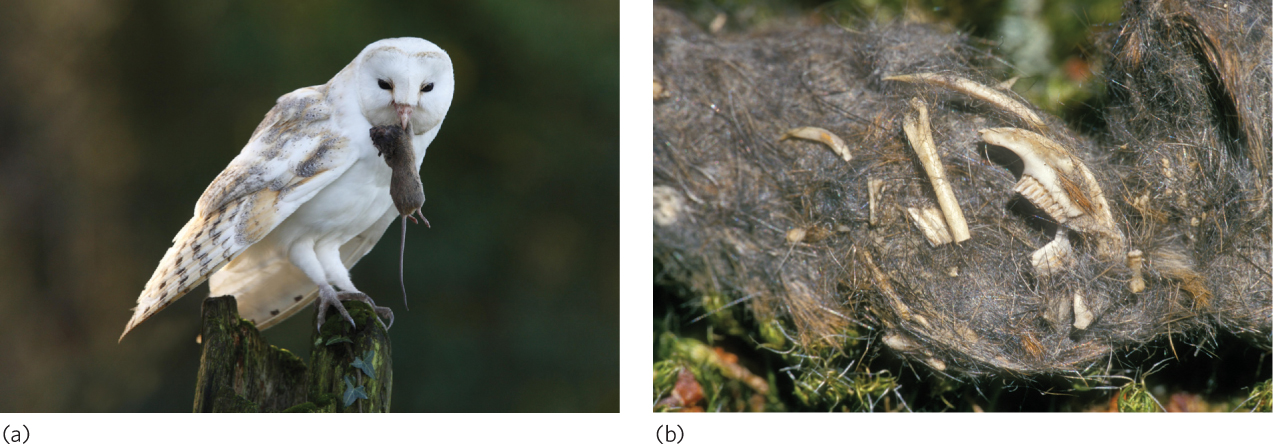
The percentage of consumed energy that is assimilated is known as the assimilation efficiency. We can calculate assimilation efficiency as follows:
Assimilation efficiency The percentage of consumed energy that is assimilated.

Assimilation efficiency varies a great deal among trophic levels. For example, herbivores that feed on seeds, such as many species of birds and rodents, have assimilation efficiencies as high as 80 percent. In contrast, herbivores, such as horses that feed on grasses and woody vegetation, have assimilation efficiencies of 30 to 40 percent. Secondary consumers, which are predators on the herbivores, typically have high assimilation efficiencies, ranging from 60 to 90 percent. These high assimilation efficiencies occur because prey tissues are generally more digestible than plant tissues.
Net Production Efficiency
Ultimately, we want to know how much assimilated energy is converted into the growth and reproduction of the organisms in a trophic level. The percentage of assimilated energy that is used for growth and reproduction is the net production efficiency. Net production efficiency is calculated using the following equation:
Net production efficiency The percentage of assimilated energy that is used for growth and reproduction.

Put another way, net production efficiency is the percentage of assimilated energy that remains after respiration. For active homeothermic animals that must spend a large fraction of their energy to maintain a constant body temperature, move about, circulate their blood, and balance their salts, net production efficiency can be as low as 1 percent. In contrast, sedentary poikilothermic animals, particularly aquatic species, channel as much as 75 percent of their assimilated energy into growth and reproduction.
Understanding net production efficiency also has practical applications. For example, livestock producers understand that if they keep their animals indoors at high densities during the winter, the animals will spend less of their assimilated energy on respiration to maintain a constant body temperature. If they are kept warm, the animals will devote more of their assimilated energy to growth, and faster growing livestock result in more income for the livestock producer.
483
Ecological Efficiency
Now that we understand the three efficiencies that occur within each trophic level, we can explore the efficiency of energy transfer between adjacent trophic levels. Ecological efficiency, also known as food chain efficiency, is the percentage of net production from one trophic level compared to the next lower trophic level.
Ecological efficiency The percentage of net production from one trophic level compared to the next lower trophic level. Also known as Food chain efficiency.

When we consider all of the efficiencies in the chain of events that starts with consumption and ends with net production, we can see that each plays a role in determining the ecological efficiency between trophic levels. To confirm that this is true, we can multiply the efficiencies in each step of the process to produce the equation for ecological efficiency:
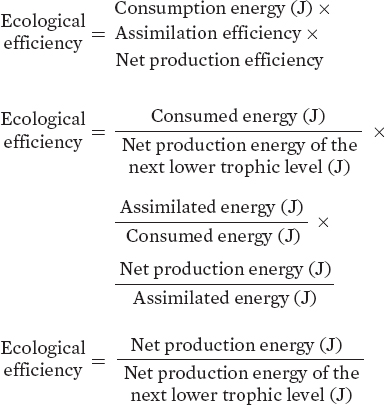
Because energy is lost at each of these steps, ecological efficiencies are typically quite low and range from 5 to 20 percent. Given this range, ecologists often use 10 percent as a rule of thumb.
An ecological efficiency of 10 percent between adjacent trophic levels means that only 10 percent of the total energy present in the producer trophic level will be found in primary consumers, and only 1 percent will be found in secondary consumers. As you can see, an ecological efficiency of 10 percent makes it difficult to have long food chains in an ecosystem because there is not enough energy to support additional higher trophic levels. The only way to support additional trophic levels is by increasing the amount of absolute energy entering at the producer level or by increasing the ecological efficiencies moving between adjacent trophic levels.
A 10 percent ecological efficiency also has relevance to humans and where we feed along a food chain. For example, when we act as a primary consumer and eat plants, we can assimilate 10 percent of the energy available from plants. However, when we act as a secondary consumer and consume herbivores, we assimilate 1 percent of the original energy that was in the plants. As a result, we would expect a diet composed of more plants and less meat to dramatically increase the amount of food available to humans.
Ecological Efficiency and the Number of Trophic Levels
Aquatic ecosystems typically have more trophic levels than terrestrial ecosystems, in part because of differences in ecological efficiencies. In terrestrial ecosystems, producers are composed primarily of plants that range in size from wildflowers to trees. In many of these plants, a large proportion of tissue is dedicated to deterring herbivores from consuming them. Other plants contain an enormous proportion of biomass that herbivores cannot consume, such as the wood of trees. As a result, there is a low consumption efficiency in terrestrial ecosystems, so a large fraction of the producer biomass ultimately becomes detritus. In contrast, aquatic ecosystems are composed primarily of unicellular algae that contain fewer defenses and are relatively easy for herbivores to digest. Therefore, algae provide higher consumption and assimilation efficiencies to their herbivores, which leads to higher ecological efficiencies. These higher ecological efficiencies mean that a higher fraction of the ecosystem’s energy can move up the food chain and support additional trophic levels in aquatic ecosystems compared to terrestrial ecosystems.
In addition to having higher ecological efficiencies, aquatic ecosystems also contain herbivores that are generally quite small, such as the tiny zooplankton that consume algae. These zooplankton are consumed by secondary consumers such as small species of fish. These small fish are consumed by medium fish, which in turn are consumed by large fish. Because the producers are mostly single-cell algae, and because each successive consumer is only a bit larger than the diet it consumes, aquatic ecosystems can often contain five trophic levels.
484
ANALYZING ECOLOGY
Quantifying Trophic Efficiencies
To help us understand how we calculate trophic efficiencies, we can use data collected from aquatic and terrestrial ecosystems to calculate consumption efficiency, assimilation efficiency, net production efficiency, and ecological efficiency.
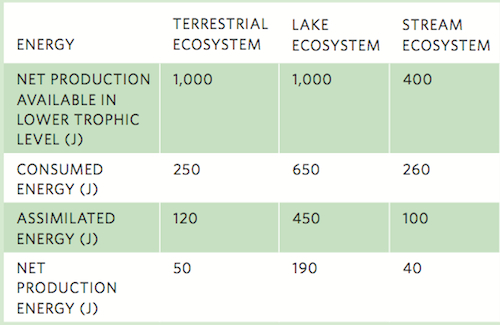
We can calculate these efficiencies using the data from the terrestrial ecosystem.
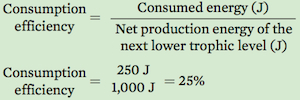
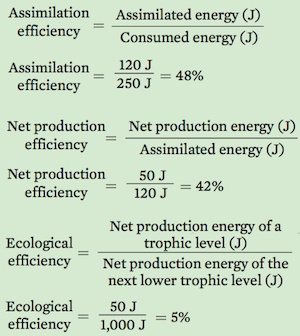

Based on these calculations, why do the two aquatic ecosystems have higher ecological efficiencies than the terrestrial ecosystem? Which efficiencies cause the stream ecosystem to have a lower net production energy than the lake ecosystem?
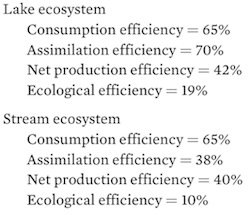
The two aquatic ecosystems have higher ecological efficiencies than the terrestrial ecosystem primarily due to higher consumption efficiencies.
In this example, the lower ecological efficiency in the stream ecosystem compared to the lake ecosystemis caused by a lower assimilation efficiency in the stream ecosystem.
We can contrast this with the situation that occurs in terrestrial ecosystems. In terrestrial ecosystems, the producers are relatively large, ranging in size from wildflowers to large trees. In addition, many of the major herbivores such as deer and antelope are quite large and can be consumed only by very large secondary consumers such as wolves and lions. Because terrestrial ecosystems contain many large producers and large herbivores, they are less likely to have a fourth and fifth trophic level. In short, the low ecological efficiency of terrestrial ecosystems combined with the large size of many producers and herbivores results in terrestrial ecosystems that commonly contain only three or four trophic levels.
Residence Times
Ecological efficiency tells us the proportion of energy that moves from producers into the higher trophic levels. We also want to examine the rate of energy movement between trophic levels, which tells us how long energy remains in a given trophic level and, therefore, how much energy can accumulate at that level. We can define the length of time that energy spends in a given trophic level as the energy residence time. Energy residence time is directly related to the amount of energy that exists in a trophic level; the longer the residence time, the greater the accumulation of energy in that trophic level. The average residence time of energy at a particular trophic level equals the energy present in the tissues of organisms divided by the rate at which energy is converted into biomass, or net productivity:

Energy residence time The length of time that energy spends in a given trophic level.
485
If we substitute biomass for energy in this equation, we can determine biomass residence time, which is the length of time that biomass spends in a given trophic level.
Biomass residence time The length of time that biomass spends in a given trophic level.

For example, plants in humid tropical forests produce dry matter at an average rate of 1.8 kg/m2/year and have an average living biomass of 42 kg/m2. Inserting these values into the preceding equation gives a biomass residence time of 23 years. Average residence times for primary producers range from more than 20 years in forest ecosystems to less than 20 days in aquatic phytoplankton-based ecosystems. This much shorter biomass residence time in aquatic ecosystems is the reason these ecosystems frequently have inverted pyramids of biomass, like the one shown in Figure 20.14b; the biomass produced by algae is rapidly consumed by zooplankton.
These residence times track the movement of energy that is consumed from one trophic level to another by primary, secondary, and tertiary consumers, but these estimates do not take into account the residence time of the dead organic matter that is consumed by scavengers, detritivores, and decomposers. We calculate the residence time in dead organic matter using another variation of the equation for energy residence time:

For example, the residence time of dead leaf litter is 3 months in humid tropical ecosystems, 1 to 2 years in dry tropical ecosystems, 4 to 16 years in temperate forest ecosystems in the southeastern United States, and more than 100 years in temperate mountains and boreal ecosystems. As you can see from the preceding equation, these differences in the residence times of leaf litter are a function of how much litter falls each year and how rapidly decomposition can occur. In lowland tropical regions, warm temperatures and abundant moisture allow rapid decomposition of litter, while the colder and drier conditions of temperate and boreal ecosystems slow decomposition, which causes litter to accumulate.
Stoichiometry
Ecological stoichiometry The study of the balance of nutrients in ecological interactions, such as between an herbivore and a plant.
In addition to obtaining energy, organisms also must have the correct balance of nutrients to grow and reproduce. Ideally, the ratio of nutrients an organism needs must match the ratio of nutrients it consumes, but sometimes this is a challenge. The study of the balance of nutrients in ecological interactions, such as between an herbivore and a plant, is called ecological stoichiometry. Understanding ecological stoichiometry is useful in explaining variation in the ecological efficiencies that we have just discussed.
The balance of nutrients required by different species depends on their biology. For example, diatoms have high requirements for silicon because they produce glass shells for protection (see Figure 2.5). In contrast, vertebrates require large amounts of calcium and phosphorus for growing bones and scales. Fruit-eating birds and mammals often must supplement their diets with snail shells or bits of limestone to take in sufficient amounts of calcium and phosphorus. Growth rates and other life-history traits also can influence the nutrient composition of organisms. For instance, if we compare two types of zooplankton, we find that slowly growing marine copepods (Figure 20.16a) have nitrogen to phosphorus ratios as high as 50:1 whereas rapidly growing freshwater water fleas (Figure 20.16b) have ratios below 15:1. The faster growing water fleas have a lower ratio because they must maintain high concentrations of phosphorus in their tissues to synthesize the large amounts of proteins necessary for rapid growth.
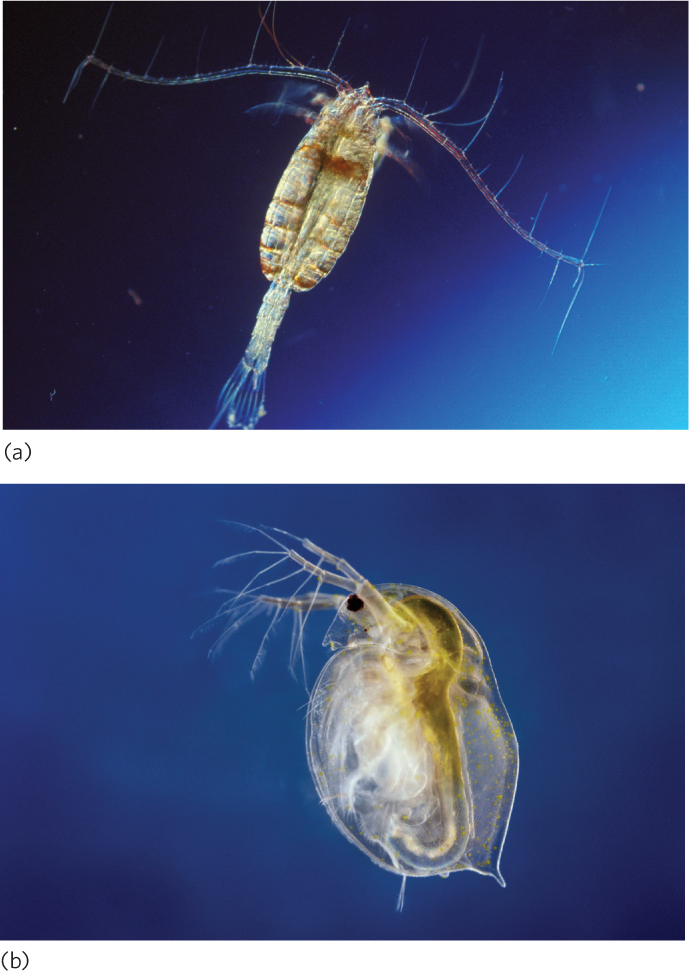
To understand how stoichiometry affects the efficiencies of energy transfer between adjacent trophic groups, consider again the water flea that has tissues containing a 15:1 ratio of nitrogen and phosphorus. When the ratio of ingested nutrients does not match the ratio of needed nutrients, consumers must process larger amounts of food to obtain sufficient amounts of the most limiting nutrient. If the water flea consumed algae that contained a 30:1 ratio of nitrogen and phosphorus, it would have to consume twice as much algae to meet its phosphorus need. Moreover, when it consumed algae containing a 30:1 ratio, it would have to excrete the excess nitrogen. In this example, the assimilation efficiency of the water flea, in terms of nitrogen, declines and therefore the ecological efficiency of the trophic level declines. As you can see, tracking the ecological stoichiometry helps us understand why there can be a low ecological efficiency whenever a nutrient-poor producer is consumed by an herbivore that requires a nutrient-rich diet. In short, understanding ecological stoichiometry helps us explain why ecological efficiencies can vary between trophic levels.
486
In this chapter, we have explored how energy moves through ecosystems. We have seen that this process begins with producers capturing the energy of the Sun and converting it into producer biomass. The rate of primary production influences the rate of production for higher trophic levels. We have seen that the amount of primary productivity differs among ecosystems around the world because of variations in temperature, precipitation, light, and nutrients. The amount of energy that passes through the trophic levels of ecosystems depends on the efficiency of each step in the chain, with all of the steps producing an overall ecological efficiency between adjacent trophic levels and different residence times of energy, biomass, and dead organic matter.
487
ECOLOGY TODAY CONNECTING THE CONCEPTS
FEEDING AN OCEAN OF WHALES
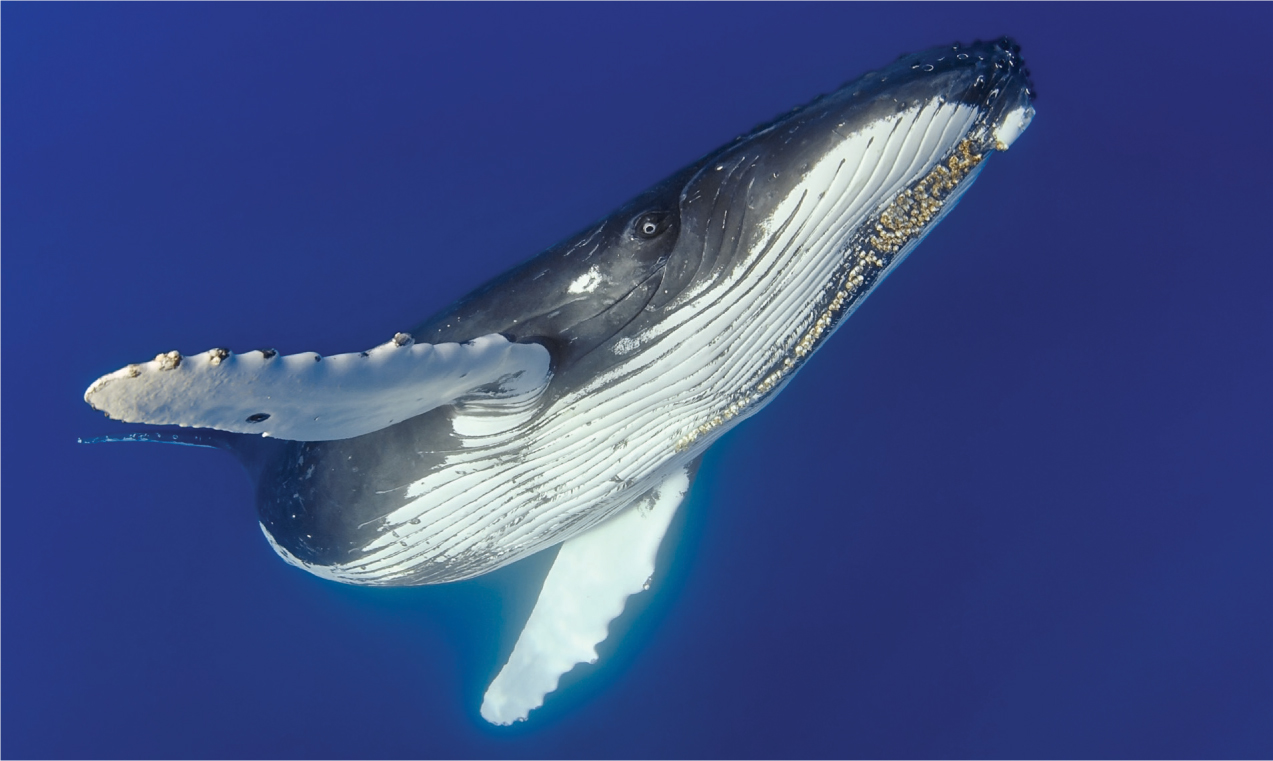
The ocean contains a diversity of species feeding at different trophic levels, and whales sit at or near the top trophic level. Although whales are a top predator, it has been a long-standing challenge for us to understand how much NPP is required to provide the energy that whale populations need. Knowing the NPP requirement would tell us how much energy passes through this trophic level. It would also allow us to estimate how much NPP whales used prior to the commercial hunting that has caused many whale populations to decline during the past century. The reduction in consumed NPP could potentially be consumed by other species in the ecosystem.
Given that most whales live in the open ocean, how does one begin to estimate the percentage of NPP that whales consume? A group of researchers decided to tackle this challenge by starting with information about the whales and working down to the producers. First, they settled on a particular study area: the region of ocean within 550 km from the western coast of the United States. Next, they needed to estimate how many whales lived in this area. Fortunately, line transects had been conducted in this region of the ocean for 15 years and these transects provided abundance estimates for 21 species of whales that included dolphins, porpoises, sperm whales (Physeter macrocephalus), and humpback whales (Megaptera novaeangliea). By knowing the typical mass of an individual whale for each species and how much energy whales of different sizes consume, assuming an assimilation efficiency of 80 percent, the researchers could estimate the total energy consumed annually by each species of whale.
The next step was to determine the diet of each whale species. Each species has a unique diet of prey comprised of different proportions of primary consumers, such as krill, and secondary consumers, such as fish. Using existing data on whale diets, the researchers knew the proportion of primary and secondary consumers that each whale species eats. They then used the ecologist’s rule of thumb that adjacent trophic levels passed along energy with an ecological efficiency of 10 percent. Based on this rule of thumb, they could determine how much NPP was required to produce the prey consumed by the whales.
488
The final step was to determine how much NPP was available in this region of the ocean. They measured NPP using satellites and the remote sensing techniques for detecting chlorophyll concentrations that we discussed earlier in the chapter. Once NPP was quantified, they determined that whales consumed about 12 percent of the ocean’s NPP. For comparison, this is about half of the NPP required to support fish populations that are commercially harvested.
The percentage of NPP currently used by this group of mammals is likely to increase dramatically in the coming decades. For example, during the 1980s and early 1990s, many dolphins were accidentally killed by commercial fishing operations. Because this source of mortality has declined in recent years, we anticipate an increase in the number of some types of whales, such as dolphins. This may cause a higher proportion of the NPP to be consumed. Moreover, because many of the larger species of whales are now protected around the world, populations are rising. Scientists expect populations of some of the larger species to eventually triple or quadruple, which will result in an even greater consumption of the ecosystem’s NPP. Although researchers do not yet know how this large increase in the biomass of top predators will affect the ocean’s distribution of energy among the trophic levels, such an increase will undoubtedly be investigated in the decades to come.
SOURCE: Barlow, J., et al. 2008. Cetacean biomass, prey consumption, and primary production requirements in the California Current ecosystem. Marine Biology Progress Series 371: 285–295.